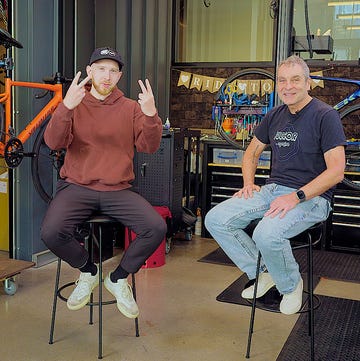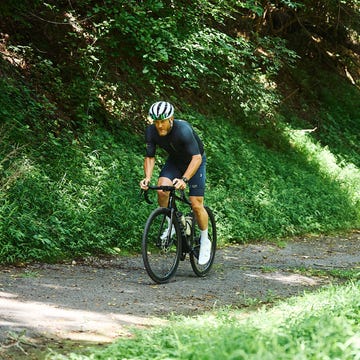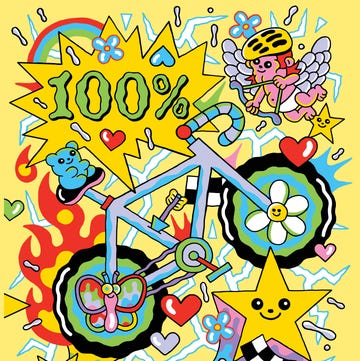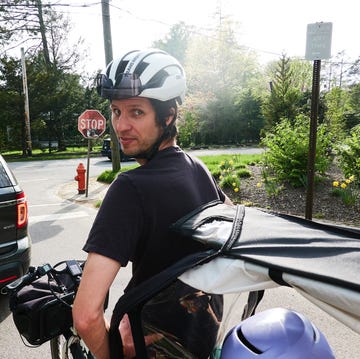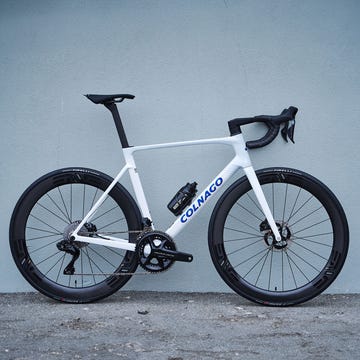Custom. The word evokes passionate opinions about what constitutes a custom-made bike and who gets to ride one. There’s this idea that they’re wildly expensive pieces of functional art meant only for the fittest, fastest riders.
That’s simply false. Custom is an expansive term that can mean different things to people. The fact is, almost every rider customizes their bicycle to some degree when choosing saddles, bar tape, accessories, or component sizing. And the definition also varies from one brand or frame builder to another.
We’ve spent years testing nearly every production bike on the planet, and we’re here to tell you that a custom bike might be the smartest choice for you—no matter what kind of rider you are. With production road, gravel, and mountain bikes now regularly carrying five-digit price tags, a bicycle designed to fit your specific riding needs might cost less than a top-of-the-line stock bike and provide better value.
What Is Custom?
Broadly speaking, custom means not stock. Stock bikes are what you typically see when you walk into a bike shop. These bikes, often from large manufacturers, come out of boxes with all parts and dimensions locked in. And companies usually offer them in only one or two predefined finishes.
Custom bikes are generally made by much smaller companies. This could be a one-person operation run out of a backyard shed, or a brand with a handful of employees. Either way, it’s probably not an outfit with an HR department (or any departments, really).
These low-volume, craft builders typically make most of their goods in-house. Many do it as a full-time job, while for others it is a side or passion project. Hundreds of these brands from around the world fuel the ever-growing small frame builder and custom-bike community.
Some of these builders offer full-custom, one-of-a-kind bikes. They make bespoke frames with geometry, tube sets, frame shaping, and paint designed for only one person: the buyer. These frames may be adorned with an individualized build kit of hand-picked parts and accessories. Sometimes, the parts themselves are custom-made or custom-finished.
However, only some craft builders offer these completely personalized bikes. Many builders—most even—offer custom geometry, tube sets, and paint if the buyer requests (or needs) it, but they primarily work from a set menu with varying degrees of personalization.
A set menu makes it easier and faster for everyone. A true blank slate frame or bike is costly, complex, and time-consuming to produce. So most craft builders are willing to tweak and personalize the product enough—and within reason—that the buyer gets a unique bike more suited to their needs and desires than a stock product, but without the heavy lifting of a fully bespoke bicycle.
Specialized won’t add a centimeter or two to the head tube of a Tarmac so that fewer spacers under the stem are needed; Cannondale will not add a pump peg to a Synapse at a buyer’s request; and Canyon will not paint your new Grizl in the colors of your favorite sports team. Craft builders are happy to do all this and more. Or less.
That’s partly because small brands are more agile and can change course faster than massive global brands. Smaller brands also are usually the first to build equipment for riders’ evolving needs. Gravel bikes, all-road bikes, and various mountain bike trends—perhaps most famously, the mountain bike itself—were born and nurtured by craft builders before the big brands jumped in with mass-produced options.
While small builders often lead trends, they’re also the last bastion for high-end bikes with beloved features deemed passé by mainstream bike manufacturers. If you want a performance-oriented bike with components such as rim brakes and quick-release wheels—or made from steel, titanium, or multi-material blends—small and custom makers are the only places you can turn.
For almost any wild desire you have for a bike uniquely suited to your needs, there is a small builder that can make it a reality.
However, if you don’t want to invest in a fully custom bike, several popular brands offer different levels of personalization to their stock products.
Trek’s Project One offers finish and limited build-kit customization options for the brand’s top-level platforms. If a Trek isn’t your style, Spanish brand Orbea and Ridley from Belgium offer limited customization options (finish and parts) across many models in their range. And if you prefer something less mainstream, California upstart BlackHeart can Cerakote-finish its titanium and aluminum road and gravel frames for you in any of 137 colors and offers many choices for component groups, wheels, and cockpits on complete bikes.
Regardless of the level of customization you choose, the purchasing process will be unlike any other bicycle buying experience. You cannot simply walk into your local bike shop, test ride a few options, and roll to the coffee ride the next morning on your custom or personalized bike. Getting even a stock frame with custom paint will take three or four weeks (at a minimum) before it is built and on the road or trail. The lead time for a custom-geometry bike can range from a couple of months to a couple of years, so plan accordingly. If you need a bike immediately, get a production bicycle.
Get a Bike Fit
In my three-decade career as a test editor, I (Matt Phillips) have had at least a dozen custom bikes. And I will tell you a secret: All had a geometry within millimeters and half-degrees of the average stock 54cm(-ish) or medium frame.
Even so, my first custom bike—a Seven—was special and rode beautifully. It sticks in my head as one of my favorite bikes ever. However, something much less expensive than my first custom frame significantly improved my comfort and performance on the bike. And it forever changed my cycling experience for the better.
About a decade ago, I did the best thing I’ve ever done for my cycling: I paid for a fit by Paraic McGlynn at Cyclologic in Scottsdale, Arizona.
McGlynn is one of the best fitters in the business. Some highlights of his impressive resume include running the Serotta International Cycling Institute fit school from 2008 to 2012, co-creating Trek’s North American dealer fit education programs, and providing fit and performance consultation services for Trek’s athletes across all disciplines. In addition, McGlynn founded Cyclologic, a full-service bike shop with an impressive 3D-motion-capture fitting system. It accounts for the rider’s aerodynamics, power, and heart rate in addition to typical comfort measurements.
Working with McGlynn was a game-changer. Still, what’s most remarkable all these years later—given how much this fit improved my cycling experience—was that McGlynn didn’t make massive changes to the position I had figured out for myself after decades of riding. Instead, he made a host of minor adjustments all over the bike—right down to my cleat position and insole canting.
Those changes, cumulatively, were an exponential improvement. The day of this fit was the day I virtually stopped suffering from saddle sores. This was due to a saddle recommendation based on a pressure-mapping system developed by the German company, gebioMized, which is part of Cyclologic’s fit service.
That one sheet of paper with all my fit data is now so fundamental to my cycling enjoyment that I feel stupid for not investing in it earlier. I use my Cyclologic fit information as a template to set up the stock-geometry bikes I test and as a guide when custom bikes are made for me.
There’s no point in investing in any customized bike without having a professional fit from a reputable and experienced bike fitter—not from some jabroni who watched a video on YouTube. It could reveal things that only a custom bike can address. Or the results could be like mine: free of much that needs special accommodation but full of little changes that make every ride better. Either way, you’ll have information that will help you make better equipment decisions and will improve every single ride —M.P
Stinner Refugio
A Stock Geometry Bike With Custom Paint
By Matt Phillips
This titanium Stinner Refugio gravel frame is a great example of how I use a good fit to guide my custom bike choices.
As a preface, I’m not millimeter-persnickety about bar reach and stack. I care more about having my saddle in the right place (height and offset) and my handlebar width dialed in—things Cyclologic recommended—than I do about other geometry details. But I’ve been jumping on test bikes for nearly 30 years, and I adapt to subtle differences without even thinking.
I’m not wedded to a specific steering or handling. I know some riders are very particular and want the same feel from every bike; I’m not that picky. Besides, rather than trying to reproduce the same bicycle from different builders, I prefer that each bike has the unique personality of the builders themselves.
Stinner offers custom geometry for a very reasonable $250 upcharge—and little to no additional lead time—as well as six stock geometries. I didn’t approach this bike with either in mind. I sent off my Cyclologic fit data and coordinates from another gravel bike—an Argonaut GR3—that I had recently tested, and enjoyed getting Stinner’s advice.
Stinner’s director of operations, Jeremy Platt, plugged my numbers into BikeCAD and determined that everything would be in the right place on the stock 50cm frame with a stem that is 80mm long by –7 degrees. He also recommended one 10mm headset spacer and a 25mm offset seatpost with the saddle pushed back almost to its limit.
With geometry sorted, it was time to pick the tube set. Stinner offers three tubing options for the Refugio. From least to most expensive, they are steel, titanium, and lightweight butted titanium. These tube sets are tuned based on frame size and the individual buyer. So even a “stock” Stinner has customized tubing. That’s not something you get when you buy a Giant or Cannondale.
I chose butted titanium—not to save weight but because I’ve ridden enough ti frames to know that butted offers the supplest ride. Since this bike is intended for adventure-style gravel riding, I placed comfort high on the priority list.
Custom bikes are special. They allow you to tweak and adjust the little things that matter most—and those little things can be anything. In fact, the thing I spent the most time discussing with Stinner—the thing that caused me the most anxiety and doubt—was the paint. I went with titanium and not steel, so paint was not mandatory. But I’m tired of the same old battleship-gray raw titanium bikes—I love colorful bikes.
Stinner offers 11 predesigned paint schemes, each with a huge number of options—gloss or matte, metallic or solid—within. Stinner will also go off-menu—for an extra charge, of course.
After spending hours playing with different schemes, I finally settled on one—Stinner calls it Shoreline—as my favorite. But the scheme has four colors, plus logo color, that need picking. That’s thousands of potential combinations. Stinner’s online color picker was fun…for a few hours. Then it started to become frustrating. I tried countless combinations and solicited input from my wife and coworkers but remained paralyzed.
Finally, Stinner’s director of design and lead painter, James Bellerue, swooped in to offer his expert opinion. Using threads from some of my attempts, he suggested the paint you see here. I was relieved to put the paint saga to rest, and the result looks amazing.
However, I made one last-minute request: a metal head badge instead of the standard painted logo. The polished stainless steel head badge is a pricey $160 option that adds weight and aero drag (probably). But given the choice, I always opt for a tactile and three-dimensional badge over paint. It’s just a little thing I care about—the kind of little thing a custom bike lets me obsess over.
Certainly, I could have obsessed over custom fit and handling geometry to go with the Stinner’s custom paint. If I wanted to get picky and specific, I could have requested custom geometry to address a few things. Some are cosmetic. For example, a taller head tube so I didn’t need to use the 10mm spacer, and a longer seat tube so I didn’t have as much exposed post. Changes that might make the bike more aesthetically pleasing.
More significantly, I could have asked for a slacker seat-tube angle to allow the use of a zero-offset post. With a rigid post, zero or 25mm offset doesn’t matter much to me—the offset is merely a dimension that interplays with the seat-tube angle to get the saddle in the right position.
However, the slacker seat-tube angle would be crucial if I wanted to use a RockShox Reverb AXS XPLR dropper post, which is offered only in zero offset. With the stock seat-tube angle, I can’t get the saddle back far enough on a zero-offset post to achieve my fit. I sacrificed that option by going with stock geo—or, at least, I sacrificed the option of getting my best fit with the Reverb dropper.
But I saw no need to opt for the extra charge and the additional back-and-forth with Platt to dial in the geometry. You may feel different, and that’s okay. It’s your bike, after all, and you can be as hyper-picky as you want when customizing it.
If you want a Stinner and require neither custom geometry nor custom paint, the brand recently launched a stock program with complete builds priced at less than $4,000.
Researching the builders you’re considering for your custom bike is essential. You want to ensure their bike philosophy aligns with your desires. Because many builders, even if they offer full-custom frames, won’t deviate much from the feel and handling personality they’ve cultivated for their brand. Mosaic, for example, builds its titanium bikes on the stiffer end of the spectrum because that is what the brand feels performs best, so you’re not likely to convince Mosaic to build a whippy and ultra-supple titanium frame.
That’s why you should interview the builder you’re considering. After all, you’re hiring them for an important job: to build a bike as close to perfect for you as possible. That might mean some builders you’ve lusted after on Instagram aren’t a good match for you. But with today’s custom market so rampant with fine builders, you’re almost guaranteed to find someone out there who will make a bike uniquely perfect, or almost so, for you.
There’s also a chance that you find a builder who makes a bike so aligned with your preferences that you won’t need a fully customized bike. After many hours riding this Stinner, I have no regrets about the choices I made and didn’t make. I love how it looks. It immediately felt like “my” bike and is almost exactly what I wanted—“almost,” because the perfect bike doesn’t exist.
My preferred position was achieved, and the bike offers a dreamily smooth and stable ride that can handle a wide range of gravel and is quite capable on some mountain bike trails, too. I’ve ridden racier-feeling gravel bikes, but the Stinner’s limits are greater thanks to its longer wheelbase and mountain-bike-esque cockpit with a shorter stem and longer front center.
And while it doesn’t have the explosive acceleration feel of a gravel racer, the Stinner is snappy. Once up to speed, it greedily hangs onto momentum. The Stinner might not feel quick, but it is a very fast bike.
Especially on downhills, the bike is something approaching magical. The traction and control are superb, with handling approaching a perfect balance of reactivity and steadiness. The Stinner is a freight train on descents. I smoked a few tires from hitting the rocks so hard.
This led me to fit the widest tires the Refugio can fit (50mm) with inserts. The added weight ultimately wasn’t an issue, as this bike was never intended to be my gravel race bike. Still, I’ll reach for it for the most demanding races because it is so wonderfully smooth and stable.
I received the Stinner as a frameset that I assembled into a complete bike, which afforded me an up-close look at the handiwork. The bike went together easily thanks to nicely cut threads and well-prepared surfaces, and the craftsmanship and finishing are superb.
Firefly Gravel
A Mass(achusetts)-Produced, Bespoke Bike
By Tara Seplavy
A custom bike should not be rushed into. You should research the frame builder. Then, carefully consider your geometry needs and the bike’s details and finish before spending money on something that, for most cyclists, is a once-in-a-lifetime purchase. However, perhaps don’t take as long as I did to get a bicycle custom-made for you.
In my 30 years of riding and designing bikes, I had never ridden a bicycle made exactly for me—until last year. As a product manager, I tweaked a frame drawing here or there to ensure that a sample in my size had a top-tube length or head angle closer to my preferences, but I never had something tailor-made to my body’s measurements or riding requirements.
Each year, I ride and evaluate many different bikes across all segments of cycling. Most of the bikes I test are good, some are excellent, and a few might be exceptional. But only one bike has been exactly what I wanted. Firefly’s Gravel is the product of decades of my wants, likes, and preferences paired with the expertise of talented artisans. And it connects with me on a level few bikes ever have in my lifetime of riding.
Who is Firefly?
Firefly founders Tyler Evans, Kevin Wolfson, and Jamie Medeiros opened the doors in 2011, producing custom titanium and ti-carbon (titanium with carbon tubes) bicycles and components. The brand is well known for its drop-bar bikes of all genres (road, gravel, cyclocross, and touring), and it recently updated its front-suspension and fully rigid mountain bike offerings. Prices for Firefly’s Gravel (clearance for 700x45–50mm or 650bx53mm tires) and Road Plus (fits up to 700x38-40mm or 650bx47mm) framesets start at $5,200 for custom geometry with titanium tubing and an Enve fork. Complete bike builds cost $8,000 and up. That is in the ballpark of or less than many high-end carbon production framesets and bikes from major brands. But none of those pricey production bikes are custom-built for you.
When Firefly says custom, it means everything. Geometry, tube set, fork choice, dropouts, cable routing, mount points, finish options—if you have particular needs or desires, Firefly already has you covered or will work diligently to figure out how to make it happen. The brand even offers solutions for mounting electric bike motors and Pinion gearboxes.
The cost of these options can quickly add up. So, think about your needs carefully unless you have an infinite budget to work with. With the frame, titanium fork, 3D-printed yoke, stem, post, accessories, and anodize-fade finish, the Gravel’s price tallies to over $12,000. For some, the price may seem absurd. However, many cyclists see it as a small price for a bicycle that meets their needs to an exacting level.
In its 13 years, Firefly has built about 1,400 frames—fewer than some big brands produce in only one frame size in one model each year. While building only 110 bikes per year means there aren’t many other Fireflies around or coming up for sale used, it also means the waitlist to purchase one is long—currently sitting at 14 months.
Firefly also sells its components separately, several were co-developed with Josh Ogle. The $375 custom titanium stem—available in 40mm to 150mm lengths and angles from –17 degrees to 17 degrees—is a potential fit solution for many riders needing longer or lower positions on their bikes. Additionally, Firefly sells custom titanium forks priced from $2,000 to $2,450. The forks are tested to the ISO 4210-6 fatigue standard and use 3D-printed crowns and dropouts. This allows Firefly to make forks with custom offsets and lengths so that riders can fine-tune a bike’s geometry.
How This Bike Came About
While on paper my journey to riding this custom Firefly started in late 2023, it really began three decades earlier. As a high school student in the early 1990s, I saw a Somerville, Massachusetts-made Fat Chance mountain bike in the pages of a cycling magazine. I got a brochure from the brand, but the bike’s price was far too much for my earnings working at summer camp. Then in the autumn of 1994, Fat Chance left Somerville for Upstate New York, the same time I started college in Western Mass.
Shortly after, a group of ex–Fat Chance workers formed Independent Fabrication. It soon wasn’t cool in my circle of cycling friends—many who hailed from the Boston area—to want a Fat Chance. So, my desires shifted to owning a bike from the new Somerville upstart. After college, I became friendly with some of the brand’s employees and several times over the following years inquired about purchasing an IF frame. But Indy Fab’s prices surpassed my budget, and the lead times exceeded my patience. Plus, with my riding tastes shifting, I could never decide between a road, cyclocross, or hardtail mountain bike, or whether I wanted steel or titanium.
In 2011, Independent Fabrication left Massachusetts for New Hampshire. And then—reminiscent of when Fat Chance departed a decade and a half prior—a trio of ex-IF employees formed Firefly Bicycles. I was stoked about their new venture and followed the brand closely. But my cycling interests were then centered around aluminum and carbon full-suspension mountain bikes, not titanium road and cyclocross bikes like Firefly crafted. While a custom Firefly wasn’t in the cards, I knew if I ever got a custom bicycle, it would come from Massachusetts.
About seven years ago, I fell in love with road bikes again, so I contacted Mike Zanconato (another Massachusetts builder) to make me a custom bike. I finally knew what I wanted—a disc-brake-equipped road bike with handling akin to a criterium bike and clearance for much wider tires than was fashionable in 2017. I got a bike fit and put down a deposit for the frame. But then life got in the way, I changed jobs, a pandemic happened, and the bike was never made.
Fast forward to early November 2023, when I dropped by Firefly Bicycles’ Melrose, Massachusetts, shop during a visit to the Boston area. The brand recently moved into a new space, so I wanted to check it out and catch up with old friends. While there, I told Evans about an email I had received the day prior about a media-only event for Shimano’s new GRX Di2 group in mid-May 2024 for which I needed to acquire a frameset.
A few hours later I was at a rest stop along the Mass Pike when I received a text—Firefly wanted to build the bike.
The Firefly Custom Experience
Because I have known the Firefly team for many years, I was clear with Evans and Wolfson from our first call about the custom-bike project that I wanted to view the process (as much as I possibly could, at least) like a Bicycling reader would experience it firsthand. While I admittedly jumped the queue to procure the frameset quicker than Firefly’s current lead times, most other aspects of the project were as any other buyer would experience them.
The process kicked off with a call with Wolfson. We discussed my riding background and what I planned to do with the custom Firefly. Wolfson inquired about necessary component fitment requirements and the tire sizes I intended to ride. And we also talked about other bikes I rode, the aspects of those bikes I liked or disliked and why. Then we arranged a date for a bike fit.
Firefly recommends that you visit its office for a fit session with Wolfson. However, if you cannot travel to Boston, Firefly can work with you remotely or with information from a professional fitter closer to you. Bottom line: Whether purchasing from Firefly or another custom builder, spend the extra time and cost to get a fit. You are buying a bespoke bicycle; get the bike fit exactly to you.
With the custom Firefly, I sought to emulate the fit and handling traits of the Specialized Allez Sprint and Cervélo’s R5-CX. Since I already own dedicated race bikes, I wanted the Firefly to prioritize smoothness over speed. While I wanted it to grind gravel when called upon, I needed a reliable and comfortable bike for daily riding on mostly paved surfaces. The bike had to accept 700x38mm tires and fit fenders for winter riding.
I specifically liked the Allez’s cockpit proportions and agility in corners. I also appreciated the stability of the R5-CX over uneven terrain while still feeling racey. I also referenced the Cannondale Super-X and Ritte’s Esprit as bikes I felt were comfortable and that I liked the handling of.
About a month after our call, I traveled to Boston with the Allez Sprint and R5-CX. Wolfson measured the bikes and asked probing but nonjudgmental questions about my setup. Then I kitted up, and Wolfson took body-length measurements before I jumped onto the bike in Firefly’s in-house fit studio.
My most recent professional bike fit had been about seven years earlier. Over that time, not much changed with my riding position. My crank length stayed the same, and I maintained saddle height and saddle-to-bar measurement within a millimeter or two of that fit. While I didn’t have any specific fit needs addressed or ills remedied, I was very interested in confirming my settings, being evaluated by a professional, and listening to any recommendations.
On the fit bike, Wolfson adjusted the settings while I pedaled. He adjusted reach, stack, saddle setback from the bottom bracket, and seat height parameters in various directions so I could feel the effects. The position I felt most comfortable riding and generating power was remarkably close—as in a millimeter here or there—to the measurements from my previous fit and what I was riding for years.
After the fit, we talked about frame options. Wolfson and Evans showed me details on other bikes and frames at Firefly. We discussed water bottle position, cable routing, dropouts, and tire clearance. We settled on Firefly’s Gravel titanium frame as the base with Firefly’s 3D-printed chainstay yoke and titanium fork. I largely left the finish and graphics to Firefly’s discretion—though I strongly hinted that blue, pink, and purple anodized fades tickled my fancy. At the last moment, I told Firefly to add a pump peg so Bicycling test editor Dan Chabanov wouldn’t be disappointed in me.
I had some homework after leaving Firefly. Wolfson recommended a slight change to my position. I applied the changes to my bikes and spent about 200 miles riding them on the trainer and outdoors before I confirmed the geometry back to Firefly. A few more emails were exchanged about details; the original dropout I wanted would not work with the chainstay length I needed, for example. Then Firefly sent over frame drawings to confirm, and the waiting began.
Firefly invites customers to visit during the welding and building process. Since I could not make the trip to Boston for production, Firefly sent me photos of the frame getting welded by Evans and when it was completed. However, unlike most buyers, who receive their custom bikes soon after completion, I had to wait several weeks—this frameset was shipped to Shimano in California for assembly with GRX Di2.
Riding My First Custom Bike
Plain and simple, I adore this Firefly—and I should because it is exactly what I requested the builder to make—but it took some changes to make my love glow brightly. And my fondness for this bicycle grows deeper the more I ride it.
I saw the bicycle in person for the first time at the GRX Di2 launch. The Firefly is gorgeous, dynamic, and unique. While the bike was assembled with a then-unreleased component group, no one I encountered on the trail noticed the top-secret parts; the frameset is too stunning. It attracted attention and comments from editors with other outlets, bike mechanics, and racers alike. This attention from cyclists wasn’t a one-off occurrence and has remained a constant since I took possession of the bike.
Generally, media events aren’t great for testing products. It’s hard to properly evaluate an unfamiliar bike when jet-lagged and riding on roads or trails you don’t know. Shimano held its launch in conjunction with the Paydirt gravel race in Carson City, Nevada—with long climbs and fast descents on dry gravel roads in bright sun, the terrain and conditions were practically the opposite of what I typically ride near our Pennsylvania headquarters.
Though I didn’t know the trails and was riding new components, I felt comfortable on the Firefly from my first pedal strokes on the first day of the launch. I giggled as the tires broke loose in sandy corners, and smiled widely at the distinct sound of tiny gravel pebbles pinging off the down tube.
On my second day with the bike, I raced the Firefly over the 57-mile course with, at times, reckless abandon. It remained composed as I blindly descended rocky jeep roads at speed and drifted singletrack turns. The titanium fork provides subtle suspension over washboards and doesn’t feel flexy under heavy braking. The bike’s geometry and handling fully met my criteria on gravel.
On my home roads in Eastern Pennsylvania, I was not initially as enamored with the Firefly as I was in Nevada. But my criticisms had nothing to do with the frame or fork and everything to do with the components and build details. I sought a more familiar and snappy road bike feel from the Firefly.
While the new 12-speed GRX group shifts quickly and the brakes have fantastic power, my hands didn’t get along with the hood shape, I found the bar too wide, and the wheels felt slow. Plus, the GRX components looked somewhat boring and generic hanging from such a bright and beautiful frameset
The Firefly shined when I changed the drivetrain, wheels, and tires. I chose SRAM’s Force AXS group for the rebuild. I grew quite accustomed to Force’s hood shape and lever feel on other bikes I’ve tested. The ability to quickly swap chainring combos on SRAM cranks for different riding situations—50/37T for fast road days, 48/35T for all-road riding, or 46/33T for dirt roads or routes with climbing—is also better suited to the Firefly’s personality. While Shimano’s 48/31T GRX crank offers a wide gear range, you are locked into that configuration unless you change the crank and front derailleur.
For wheels, I used Industry Nine’s Solix SL AR40c. With a 25mm inner rim width, the wheels pair well with 30mm- to 42mm-wide tires—blending nicely with the Firefly’s design intent. Clad in Vittoria Terreno Zeros measuring 42mm (labeled 38mm), the AR40 wheels roll exceptionally smoothly on paved and packed-dirt roads. The Solix rear hub produces a distinct, high-end buzz when freewheeling, and when you press on the pedals, the engagement feels almost instantaneous due to the hub’s 605 points of engagement.
I rounded out the rebuild with my favorite touch points—Fizik’s 140mm-wide Vento Argo saddle and a 44cm-wide Cervélo carbon bar. I also installed a purple Knog Oi bell, a tidy Wzrd Bikes bar bag support, and SRAM’s rainbow-color chain and cassette for purely aesthetic purposes.
Changing parts allowed me to inspect some of the Firefly’s details. With the bike stripped down to only the frame, fork, post, and stem, I could closely see Evans’s welds and examine Ogle’s 3D-printed yoke and fork dropouts. These areas are often overlooked when cranks, derailleurs, and wheels get installed on a frameset. Sadly, the intricate details inside the 3D parts are welded closed, never seen by the rider.
The Firefly needed the component changes (functionally and visually) to make the bike truly feel “custom” and personalized for my riding. Weighing in close to 20 pounds with pedals, bottle cages, and a frame pump, the bike is not exceptionally lightweight. But that does not matter because the ride quality is sublime. The bike dances when I stand out of the saddle to accelerate on slight rises and sings as I push it through fast, sweeping corners.
Firefly designed a fit characteristic into this bike that I seek but rarely find in other drop-bar bikes—“in not on.” I do not feel perched above the bike but more directly attached while riding, particularly over rough surfaces or descending. My riding position feels precise when pedaling or attacking turns, and my weight is evenly centered for cornering. It matches my riding style and enhances my strengths on the bike.
Should You Go Custom?
Every bicycle is a sum of its parts—dozens of individual items combined to accomplish a goal. This is perhaps more noticed when building a fully custom bike, as you can influence almost every nuance and detail.
Practically speaking, not every rider can obtain a custom bike; most don’t even want one. But if you have the need or desire, it’s worth the investment. You will experience your bicycle in a new and more complete way.
I took a long, meandering route to get my first custom bike. In my career in product development, I helped design a lot of bicycles for others to enjoy—some had commercial success, and a few carried athletes to the top levels of cycling. Many of those bicycles mean a lot to me. But this was the first bike specifically designed for my riding wants and needs. It fits my body and personality. For that reason alone, it might be my favorite.

A gear editor for his entire career, Matt’s journey to becoming a leading cycling tech journalist started in 1995, and he’s been at it ever since; likely riding more cycling equipment than anyone on the planet along the way. Previous to his time with Bicycling, Matt worked in bike shops as a service manager, mechanic, and sales person. Based in Durango, Colorado, he enjoys riding and testing any and all kinds of bikes, so you’re just as likely to see him on a road bike dressed in Lycra at a Tuesday night worlds ride as you are to find him dressed in a full face helmet and pads riding a bike park on an enduro bike. He doesn’t race often, but he’s game for anything; having entered road races, criteriums, trials competitions, dual slalom, downhill races, enduros, stage races, short track, time trials, and gran fondos. Next up on his to-do list: a multi day bikepacking trip, and an e-bike race.
As Deputy Editor, Tara Seplavy leads Bicycling’s product test team; after having previously led product development and sourcing for multiple bike brands, run World Championship winning mountain bike teams, wrenched at renowned bicycle shops in Brooklyn, raced everything from criteriums to downhill, and ridden bikes on six different continents (landing herself in hospital emergency rooms in four countries and counting). Based in Easton, Pennsylvania, Tara spends tons of time on the road and trail testing products. A familiar face at cyclocross races, crits, and bike parks in the Mid Atlantic and New England, on weekends she can often be found racing for the New York City-based CRCA/KruisCX team. When not riding a bike, or talking about them, Tara listens to a lot of ska, punk, and emo music, and consumes too much social media.



























